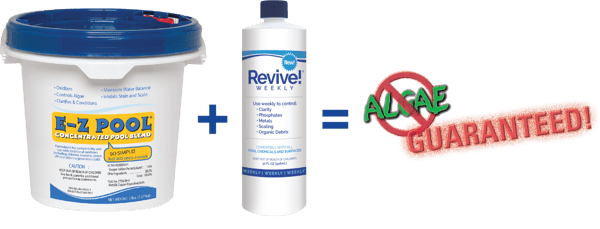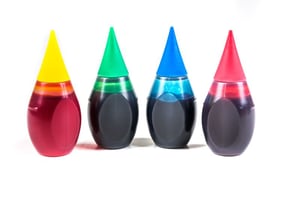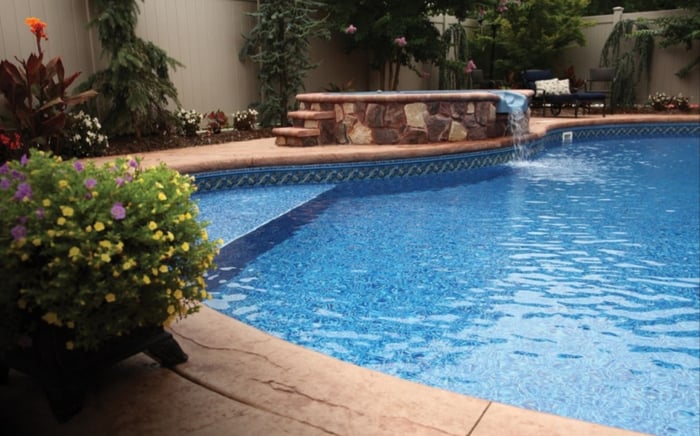Your swimming pool is the centerpiece of family fun and home to hours of summertime fun. Unfortunately, without the proper maintenance, your sparkling pool will become smelly, dirty, and just plain gross. Swimming pool maintenance isn't nearly as fun as splashing and swimming, but the right techniques can make it a breeze that allows you to quickly get back to enjoying the water. This article covers all the details of general pool maintenance which will help you not only enjoy your pool more this season but make your pool and its equipment last longer year-to-year.
We'll be covering the following topics:
- Basic Pool Maintenance
- Cleaning (Pumps, Filters and Skimmers)
- Cleaning (Vacuums and Robots)
- Water Chemistry
- Covers
- Winterizing Your Pool
- Opening Your Pool in Spring
- Vinyl Liner Leaks and Repairs
5 Steps to Basic Swimming Pool Maintenance
Basic cleaning of your swimming pool includes cleaning the water, scrubbing the vinyl walls, keeping filters maintained, and clearing the area around your pool. Use these five steps to make cleaning your swimming pool an easy task that will barely interrupt your summer fun.
1. Skim the Surface
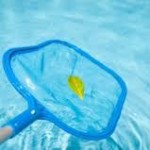 Debris accumulates on your pool's surface every day. Removing this matter will keep the water fresh and allow you to deep clean less frequently. Attach your skimmer net to a telescopic pole and sweep it across your pool's surface to remove debris. As the net gets dirty, shake debris onto the ground before putting the net back into the water. Skimming the water daily will prevent debris from sinking to the bottom of the pool.
Debris accumulates on your pool's surface every day. Removing this matter will keep the water fresh and allow you to deep clean less frequently. Attach your skimmer net to a telescopic pole and sweep it across your pool's surface to remove debris. As the net gets dirty, shake debris onto the ground before putting the net back into the water. Skimming the water daily will prevent debris from sinking to the bottom of the pool.
2. Brush the Walls
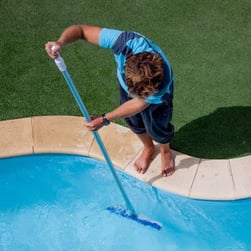 The walls of your pool need to be scrubbed to remove dirt, chemical residue, and potential algae growth. Grab that telescopic pole again and attach the pool brush. Brush the walls, ladder, and corners of your pool. Take the time necessary to ensure you don't skip any tight spaces that could allow algae to grow. Brushing pushes stuck-on dirt and algae into the water making it easier for chemicals or your pool vacuum to remove.
The walls of your pool need to be scrubbed to remove dirt, chemical residue, and potential algae growth. Grab that telescopic pole again and attach the pool brush. Brush the walls, ladder, and corners of your pool. Take the time necessary to ensure you don't skip any tight spaces that could allow algae to grow. Brushing pushes stuck-on dirt and algae into the water making it easier for chemicals or your pool vacuum to remove.
3. Vacuum the Floor
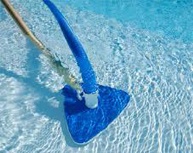
Attach your vacuum head and hose to the telescopic pole to clear debris from the bottom of your pool. To eliminate air from the system, lower the vacuum to the bottom of the pool and push the other end of the hose against a jet. When bubbles stop forming, the air is purged from the vacuum and you're ready to get to work.
Remove the strainer basket from your skimmer inlet and plug your vacuum hose into the suction port at the bottom of the skimmer.
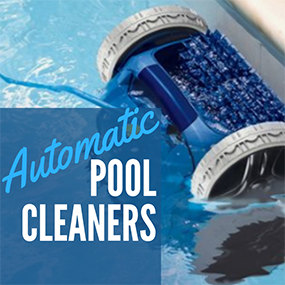
Slowly move your vacuum head over the entire floor of the pool to remove settled dirt and debris. Avoid rushing this job and stirring up the debris that will eventually settle back to the bottom of your pool. When cleaning is complete, turn the filtration system back on to remove anything you missed.
Note: Automatic cleaners are also available. While they're more expensive than a manual vacuum, they make the job considerably easier. Read more on the different types of auto cleaners here.
4. Clean the Filter
Cleaning your pool is useless if you neglect the filter. In fact, you'll be cleaning a lot more often if your pool's filter isn't clean enough to circulate the water effectively. Your pool likely has one of three types of filters. Each type requires a different cleaning method. Always follow the manufacturer's instructions to clean your filter.
Backwashing Your Pool Filter
Backwashing is the act of running your pool pump backward to flush out the system. Sand and DE filters can be back washed for a quick clean but must be cleaned thoroughly once or twice a year. To backwash your pool, turn off the filter and connect the backwash hose to the filter's waste port. Turn the valve to backwash. Turn the filter on for about two minutes. Turn the filter off and set the valve to rinse. Turn the system on for another minute. Turn the system off and set the valve to filter. If you have a DE filter, follow the manufacturer's instructions to add DE.
Cleaning Your Pool Filter
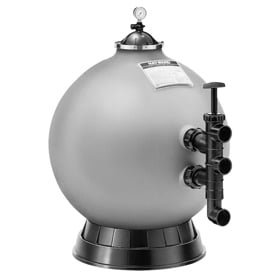 Sand Filter: Backwash the filter then turn off the pump and set it to filter. Open the pump lid and add sand filter cleaner per the manufacturer's instructions. Turn on the pump for 10-15 seconds to carry the cleaner into the sand filter. Turn off the pool pump and leave it off for 8 hours or overnight. Complete the process by backwashing again and turning the filter back to the normal setting.
Sand Filter: Backwash the filter then turn off the pump and set it to filter. Open the pump lid and add sand filter cleaner per the manufacturer's instructions. Turn on the pump for 10-15 seconds to carry the cleaner into the sand filter. Turn off the pool pump and leave it off for 8 hours or overnight. Complete the process by backwashing again and turning the filter back to the normal setting.
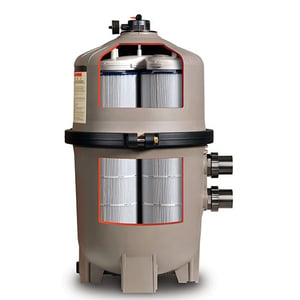 Cartridge Filter: Turn off the pump and filter and release air from the system. Open the filter and remove the cartridge. A damaged cartridge will have to be replaced. If the cartridge isn't damaged, begin by rinsing it thoroughly with a garden hose. If the filter still looks dirty, clean it with a commercial filter cleaner or soak it overnight. When the filter is clean, replace or lubricate the O ring. Rinse the cartridge and replace it in the filter. Complete the process by turning the pool filtration system back on.
Cartridge Filter: Turn off the pump and filter and release air from the system. Open the filter and remove the cartridge. A damaged cartridge will have to be replaced. If the cartridge isn't damaged, begin by rinsing it thoroughly with a garden hose. If the filter still looks dirty, clean it with a commercial filter cleaner or soak it overnight. When the filter is clean, replace or lubricate the O ring. Rinse the cartridge and replace it in the filter. Complete the process by turning the pool filtration system back on.
 DE Filter: Wear gloves and a face mask to clean your DE filter. Backwash the system, turn off the pump, and remove air from the system. Open the drain plug to let water drain from the filter. Open the filter tank and rinse out the tank. Rinse off the manifold and filter grids then check for damage. If the manifold or grids are still dirty clean with a commercial cleaner or soak overnight. Replace or lubricate the O ring and return the manifold and grids to the tank. Following your manufacturer's instructions, create a slurry of DE and water. Turn on the pump and release air from the system. Within 60 seconds pour the slurry into the pool skimmer.
DE Filter: Wear gloves and a face mask to clean your DE filter. Backwash the system, turn off the pump, and remove air from the system. Open the drain plug to let water drain from the filter. Open the filter tank and rinse out the tank. Rinse off the manifold and filter grids then check for damage. If the manifold or grids are still dirty clean with a commercial cleaner or soak overnight. Replace or lubricate the O ring and return the manifold and grids to the tank. Following your manufacturer's instructions, create a slurry of DE and water. Turn on the pump and release air from the system. Within 60 seconds pour the slurry into the pool skimmer.
5. Wash the Deck
| Sweep the area surrounding your pool to remove leaves, grass clippings, and other debris that will potentially end up back in the pool. Spray the area with a high-pressure hose or pressure washer to remove algae growth and chemical residue. Occasionally, you may need to disinfect your pool's deck to remove algae growth and bacteria. Use a specialized pool deck cleaner and a stiff brush to clean the area thoroughly. |
Water Chemistry 101
 Pool water testing is essential. Without it, there's no way to know what's in your water. While trace contaminants may not seem like a big deal now, over time they can develop into a really big problem. To avoid potential issues, it's important to test your water regularly.
Pool water testing is essential. Without it, there's no way to know what's in your water. While trace contaminants may not seem like a big deal now, over time they can develop into a really big problem. To avoid potential issues, it's important to test your water regularly.
The first thing you'll need is a water sample. To be sure to get an accurate reading, use a clean container to collect your water and try to get water from deep within the center of the pool.
Once you have your sample, you can test it using strips, a liquid test kit, or by taking it to a store that specializes in pool maintenance.
We cover the most common pool water contaminants here as well as how to test for them in your pool. Because what good is knowing how to test your water if you're not sure what to do with those findings?
However, if playing pool chemist after work or on the weekends doesn't sound like you favorite thing to do, we strongly recommend using APi pool products such as Revive! Weekly and E-Z Pool.
Either one of the products help to remove contaminants in your pool without having to know how to mix the proper amounts of chemicals together to get your desired result. When these items are used together they act to prevent issues from occurring instead of traditional pool maintenance which is reactive instead of proactive.
Plus, if you've ever swam in an pool using E-Z Pool, you already know the difference it makes in the swim experience: we're talking like swimming in fresh clean water that has zero evidence of chlorine use. Hair feels like it was conditioned and your skin never gets itchy like with other chemical products.
BONUS: When paired with Pool Frog mineral system, you can reduce your chlorine tablet consumption to 0%! Read more here.
Let's Cover Pool Covers
Pool Covers do a lot of extra work for your pool. For starters, they help keep your pool cleaner by keeping debris out. Depending on the kind of cover you have, it may also keep sunlight out of your pool which protects your pool from algae growth. More so, the proper cover can keep your loved ones safe when you're not around your pool but they are.
There are three main types of pool covers: winter covers, Safety Covers, and Automatic Covers. They each have their own set of benefits but as you go down the line, there are fewer cons to each type than the previous one.
We dive more into the details of each of these cover types, their pros, and their cons, in our article here, but here's a video highlighting the main points for each.
Winterizing Your Swimming Pool
Winterizing your pool properly can prolong the life of your pool, extend your investment, and save yourself hours of hard work come springtime. As with many things in this world, there's the hard way and then there's the easy way.
The easy way mean going back up to the top of this article and cleaning your pool thoroughly. Then use E-Z Pool to winterize. This will save you time and headache playing pool chemist again.

Cleaning and adding the proper winterizing chemicals is the first step in making your pool ready for winter. The rest has to do with making sure that water is out of your pipes and equipment. Why? When water freezes it expands and you don't want to have damage to these items and have to replace them in the Spring when you're trying to get ready for a nice swim.
Learn how to freeze protect your pool here. Once that's done it's time to cover the pool! Now, a lot of folks think that it but there are certain things that you need to do throughout the winter season to ensure that all your hard efforts now aren't wasted. For starters keep your cover clean. This means removing debris and standing water often so the integrity of the cover isn't compromised. Then follow our mid-winter check-up here.
The last tip on this one, in case you're thinking about leaving your pool open for the winter (i.e. not covering it), read over this article for helpful tips on doing this but making sure your pool is safe in the process.
Opening Your Pool for Spring in 10 steps
Opening your pool for the season brings a lot of joy looking forward to the new summer season. It's important to get off on the right foot so you can start making those memories even sooner. Here are the steps that you need to take for a successful pool opening!
- Net leaves and pump water off of the swimming pool cover
- Remove the cover from the swimming pool and clean/fold it
- Add the proper chemicals to your pool (Trust us, use REVIVE!)
- Start the pool pump - When the swimming pool water is 3/4 the way up the skimmer opening, start the pool pump. The multi-port position on your pool filter should be on rinse for about 30 seconds before being switched to the filter position.
- Net any leaves or debris from the swimming pool
- Add Shock to the swimming pool (Or REVIVE! & E-Z POOL)
- Brush the swimming pool floor and check the water's pH
- Add stabilizer to the swimming pool as directed on the bottle (Unless using E-Z Pool)
- Vacuum the pool (Or turn your autocleaner on)
- Circulate the swimming pool pump for 24-48 hrs.
3 Ways To Find Leaks in Your Swimming Pool
Over the course of the season, your pool will lose water due to evaporation and traffic. However, if you notice the water level declining rapidly, you might have a leak. Try these methods to determine if you have a leak and find its location for more in-depth instructions try this!
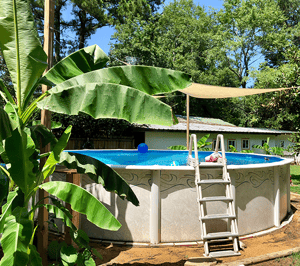
Examine the Exterior Walls
If you have an above-ground pool, it's easier to see leaks on the outside. Look for obvious damage and feel for moisture along the pool's outside walls. Check the area around the pool's features like the pump, ladder, or slide.
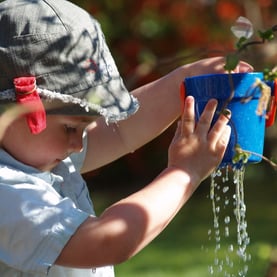
Try the Bucket Test
For both in-ground and above-ground pools, you can use a bucket to see if your pool is leaking. Fill a bucket with water up to one inch from the top. Mark the water level in the bucket. Also, mark the level of the pool's water on a sidewall. Wait 24 hours and check both water levels. If the level in the pool is significantly lower than that in the bucket, you have a leak.
Use Food Coloring
Whether you have an in-ground or above-ground pool, food coloring is a useful tool for isolating leaks. Turn off the pool's pump and filter. Fill a squeeze bottle with water and add a couple of drops of red food coloring. Place a few drops of colored water in various places around the pool. Use the ladder as a starting point and work your way around the pool. If there's a leak, you'll see the colored water flowing toward the leak. Repeat the test in areas you suspect a leak to further isolate the spot.
Taking care of your pool isn't only about keeping the water sparkly clean. It also helps maintain the life of your pool and its working parts. Swimming pool maintenance isn't difficult when you keep up a regular routine. These tactics mean your pool is always ready when you're ready to jump in.
Looking for more? Here are some of our most popular articles on this topic:
- OPEN YOUR POOL SOONER (AND A LOT EASIER) WITH POOL FROG AND EZ POOL
-
CHLORINE SHORTAGES + PRICE INCREASES LEAD TO ALTERNATIVE SOLUTIONS



